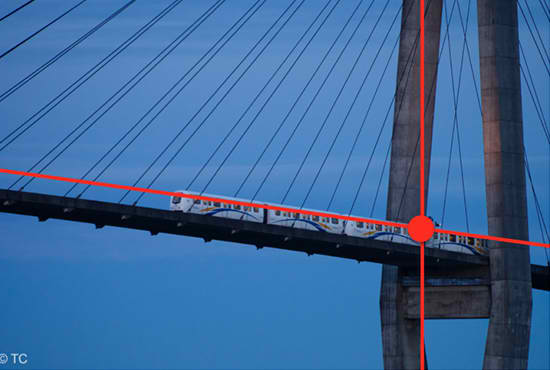Change The Angle Of View
We tend to shoot everything at eye level and this has become more prevalent with the Live View (rear LCD) option on your camera.
Consider viewing the subject of the picture from three different positions, high (elevated above the subject), at eye-level, and at a lower position (down on one knee for example). At that point you can decide which best suits the situation or shoot all three and review later in the digital darkroom.
Most digital cameras allow you to easily tilt or swivel the LCD to make shooting from a different angle much simpler.
Rule Of Thirds – How To Place The Subject In The Frame

The composition rule of thirds has been around for a very long time and shows up in most photography how to books. In other words it has stood the test of time and can be used as a good starting point for learning how to compose your pictures and make them interesting.
When you look through your viewfinder mentally divide it into thirds (some cameras have this feature built-in) try to place the subject or point of interest into one of the intersecting thirds. This can help you avoid the tendency to place subjects in the centre of the frame.
Subjects looking into or out of the frame is a personal choice. Most photographers will try to have the subject looking into the frame, but sometimes as above looking out of the frame also works and a favourite approach of mine. After shooting your pictures, using your digital imaging software you can also move your subject into one of thirds and crop at the same time.
“If your pictures aren’t good enough, you aren’t close enough.” Robert Capa
Vertical Or Horizontal Camera Angle
We live in a 16:9 world when we watch television, etc we view the world in a horizontal format and this has influenced how we take pictures, when we bring the camera up to our eye it is a rectangle viewpoint and we tend to shoot the picture without any consideration for a possible vertical photograph.
Your DSLR has the option of shooting verticals and you should consider using the vertical format when trying out a composition – it only takes a few second to see if a vertical might be a better approach for what you are photographing.
It is all about the lines
When discussing the rule of thirds the subject of horizon lines is front and centre of discussion. The tendency is to put the horizon line in the centre of the frame and all that succeeds in doing is cutting the picture in half. Low horizon line (lower half of the thirds) will give a feeling of closeness, a high horizon line will give a feeling of depth and emphasize the foreground. Simply shifting the horizon line from the centre to high or low will influence how respond to your photographs and once again you can easily do this as your are view the scene in front of you.


Strong vertical and intersecting horizontal lines can add a feeling of strength and movement.
In Summary:
- Think about the camera angle of view and lens being used – high, low, eye-level.
- When composing the image in the viewfinder and try to keep the subject out of the centre.
- Think about using shooting both vertical and horizontals of the scene.
- It is all about lines, low horizon line can add a feeling of closeness, a high horizon line can add a feeling of depth.
- Strong vertical lines and strong horizontal lines can add a feeling movement and strength.
Thanks for reading,
Terry Cioni


